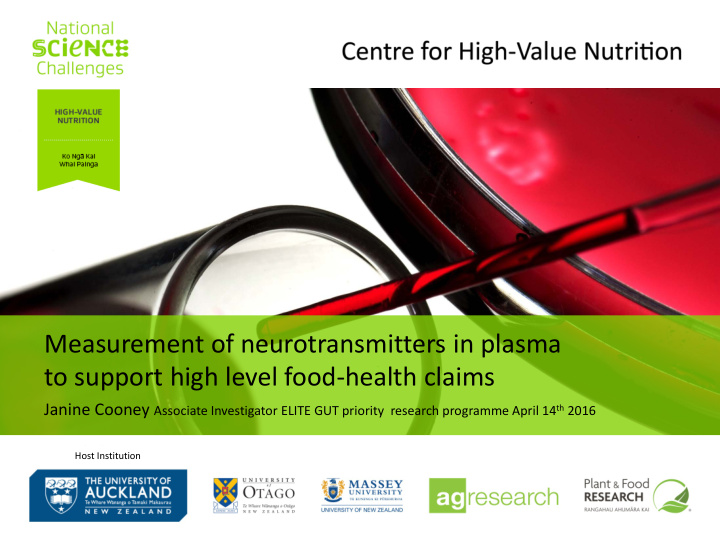



Measurement of neurotransmitters in plasma to support high level food-health claims Janine Cooney Associate Investigator ELITE GUT priority research programme April 14 th 2016 Host Institution
High level food-health claims » Mechanism of action data is required to support high level food-health claims. » Irritable Bowel Syndrome (IBS) patients are considered an appropriate study population to support claims on improved gastrointestinal tract (GIT) function and comfort as IBS is recognised as a variation to the physiological norm ( EFSA, 2015 ). » Despite being so common, the aetiology of IBS is poorly understood and a lack of robust and validated quantitative biomarkers hampers the identification and/or development of diagnosis, therapeutic and food solutions.
GIT food-health relationship » Mechanism of regulation thought due to complex interactions between: » Bi-directional communication between the gut and the central nervous system, the Gut-Brain Axis (GBA) » Genetics Microbiota » » Ability to understand the impact of food on GIT comfort and translate into food- health claims/benefits is hampered by lack of reliable biomarkers and understanding of the modes of action. http://www.optimoz.com.au/blogs/news/81659079-the- gut-and-the-brain-work-together-to-keep-us-healthy
Precisely phenotyped IBS cohort » To provide mechanistic data to support high level health claims for GIT comfort and laxation, a precisely phenotyped IBS patient cohort is required. » Rome III criteria classifies IBS into 4 subtypes based on stool transit time. Robust laboratory biomarkers are lacking. IBS-D (diarrhea) » » IBS-C (constipation) Biomarker » IBS-M (mixed) » IBS-U (unsubtyped) » Plasma, urine, breath and faecal samples from the cohort are used to precisely phenotype IBS subtypes and will generate insights into the mechanisms of action underlying different phenotypes and provide biomarkers to monitor the efficacy of nutritional interventions.
Neurotransmitters as potential biomarkers for IBS » Serotonin (5-HT) is a key neurotransmitter that plays an important role in mood and brain function as well as sensation, secretion, and absorption in the GIT. » Serotonergic signalling activity changes in the brain and GIT in IBS: plasma 5-HT is increased in IBS-D » » plasma 5-HT is decreased in IBS-C » altered plasma and tissue levels of 5-HT transporter protein SERT observed 5-HT receptors in the GIT are a target to treat » abnormal bowel action in IBS-C and IBS-D patients. Irritable bowel syndrome: A microbiome-gut-brain axis » 5-HT and it’s metabolite 5-HIAA are being disorder? PJ Kennedy, JF Cryan, TG Dinan, G Clarke. World J Gastroenterol. 2014; 20(39): 14105- investigated as biomarkers for diagnosis and 14125 . treatment of certain GI conditions, including IBS.
Measurement of neurotransmitters in plasma » Using MS probe and stable isotope coding, multiple target compounds (X) are derivatised with a probe (P) to increase their analysis sensitivity and can be measured simultaneously. An internal standard (IS) for each compound » (dX-P) is made with a labelled (deuterated or 13C) probe analogue to correct for recovery and matrix interferences. » Ratio of X-P relative to IS dX-P used for accurate quantitation.
Selected neurotransmitters can be targeted » MS probes used to measure neurotransmitters in plasma, including serotonin (5-HT), as part of a nutritional intervention study for the improvement of cognitive function.
Neurotransmitters for GIT applications » Inhibitory and excitatory neurotransmitters involved in the GBA can be measured in plasma to phenotype IBS subtypes, to generate insights into the mechanisms of action and provide biomarkers to monitor the efficacy of nutritional interventions. Excitatory Inhibitory Both » Major Neurotransmitters Glutamate GABA Dopamine Monoamines » Aspartate 5-HT Acetylcholine » Amino Acids Peptides » Others » Adrenaline 5-IAA Noradrenaline Glycine
Summary » Neurotransmitters offer a useful tool to monitor GBA activity. » GBA activity is an important factor contributing to GIT function and comfort (and also to other health areas), and plays a major role in the pathophysiology underlying IBS. » Neurotransmitters may be useful biomarkers to: » help phenotype IBS subtypes generate insights into the mechanisms of action » underlying these phenotypes monitor the efficacy of nutritional interventions » » This is vital to support high level food health claims for GIT function and comfort.
Acknowledgements » ELITE GUT Team » Nicole Roy, AgResearch (Chair) » Elizabeth Forbes-Blom, Malaghan Institute (Co-chair) Richard Gearry, Otago University (Expert panellist) » » Shane Rutherford, Massey University (Expert panellist) Karl Fraser, AgResearch (Expert panellist) » » MBIE for funding » PFR Team (Cognitive Function Berryfruit Research) » Arjan Scheepens » Tania Trower Anthony Watson »
Recommend
More recommend